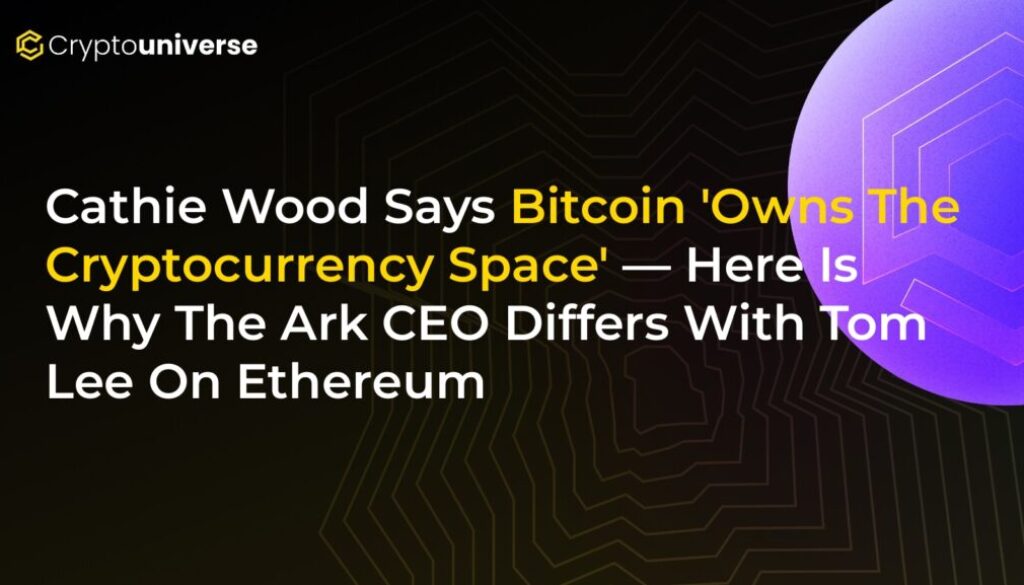Cathie Wood Says Bitcoin ‘Owns The Cryptocurrency Space’ — Here Is Why The Ark CEO Differs With Tom Lee On Ethereum

A Clash of Titans: Cathie Wood and Tom Lee Debate Crypto’s Future
In the ever-evolving world of cryptocurrency, two of Wall Street’s most influential voices, Cathie Wood and Tom Lee, have sparked a fresh debate on a fundamental question: Which digital asset will ultimately reign supreme? While both are staunch crypto advocates, their visions for Bitcoin (BTC) and Ethereum (ETH) diverge significantly. In a recent interview, Ark Invest CEO Cathie Wood made her position clear, stating that Bitcoin ‘owns the cryptocurrency space’ when it comes to being a pure, unadulterated digital currency, setting up a friendly disagreement with Fundstrat’s Tom Lee, who holds a strong bull case for Ethereum.
This discussion isn’t just academic; it highlights two competing philosophies for the future of blockchain technology and digital assets. Let’s break down their arguments to understand why these titans differ on the crypto king.
Cathie Wood’s Case for Bitcoin: The Unbreachable Digital Gold
For Cathie Wood, Bitcoin’s strength lies in its simplicity, security, and sound monetary principles. She refers to it as the “pure cryptocurrency,” emphasizing its role as a rules-based monetary system designed for one primary purpose: to be a secure, decentralized store of value.
During an interview on The Master Investors podcast, Wood outlined the core pillars of her Bitcoin thesis:
- A Rules-Based Monetary System: Wood points to Bitcoin’s foundation in the “quantity theory of money.” Its supply is hard-capped at 21 million coins, a feature that cannot be altered. This predictable scarcity makes it a powerful hedge against inflation and currency debasement, akin to digital gold.
- Unparalleled Security: “It is also a technology, a layer one blockchain technology that has never been hacked,” Wood argued. This is a critical distinction. While platforms and exchanges built around Bitcoin have been compromised, the underlying Bitcoin blockchain itself has remained secure for over a decade, a track record no other major smart contract platform can claim.
- Singular Focus: Unlike Ethereum, which aims to be a world computer for decentralized applications, Bitcoin’s primary focus is to be the most secure monetary network. Wood sees this singular purpose not as a limitation, but as its greatest strength.
Tom Lee’s Vision: Ethereum as the Future of Finance
Wall Street analyst Tom Lee, on the other hand, sees a different path to dominance through utility and programmability. While respecting Wood’s position—calling her the “GOAT” of the crypto world—Lee has laid out a powerful bull case for Ethereum, suggesting it could become the foundational infrastructure for a new global financial system.
Lee’s argument centers on Ethereum’s potential beyond just being a currency:
- The World’s Decentralized Computer: Ethereum’s smart contract capabilities allow it to power a vast ecosystem of applications, from Decentralized Finance (DeFi) and NFTs to gaming and digital identity. Lee sees this utility as a massive driver of value.
- Financial Infrastructure: He envisions Ethereum as the base layer upon which future financial products are built. This role as a settlement and infrastructure layer gives it a potentially limitless addressable market.
- An Ambitious Price Target: Lee has previously outlined a scenario where Ethereum could reach a staggering $62,000 per token, based on historical price ratios with Bitcoin and its growing dominance as a financial platform.
The Core Disagreement: Competition and Layer-2s
The central point where Wood and Lee diverge is on the topic of competition. Wood acknowledges Ethereum’s vital role in DeFi but raises a crucial concern about its long-term value capture.
She points to the rise of Layer-2 scaling solutions. These technologies are built on top of Ethereum to make transactions faster and cheaper. While they are essential for Ethereum’s growth, Wood notes that they also “end up collecting a lot of fees.” This creates a complex dynamic where value might leak from Ethereum’s main network to these competing Layer-2s, potentially diluting ETH’s investment thesis.
“These competing interests are maybe something that Tom and I can debate a little bit,” Wood remarked, highlighting this as a key area of uncertainty for Ethereum’s future.
A Nuanced Relationship
Interestingly, this debate isn’t entirely adversarial. Tom Lee is the chair of Bitmine Immersion Technologies Inc., a company focused on ETH treasury management. Cathie Wood’s Ark Invest is a significant investor in Bitmine, holding shares worth over $300 million across its various ETFs. This connection shows that while they may differ on which asset will lead, both are deeply invested in the success and maturation of the broader digital asset ecosystem.
Conclusion: Two Paths, One Crypto Revolution
The debate between Cathie Wood and Tom Lee perfectly encapsulates the two dominant narratives in crypto today. Is the most valuable asset the one that perfects the role of digital money, like Bitcoin? Or is it the one that provides the foundation for a new, decentralized internet, like Ethereum?
Wood’s perspective champions Bitcoin as a finished, robust, and secure monetary protocol—a safe haven in a world of digital complexity. Lee’s view champions Ethereum as a dynamic, evolving platform for innovation with near-limitless potential. Ultimately, the market may decide there is more than enough room for both to succeed, serving different but equally vital roles in the financial and technological revolution ahead.


